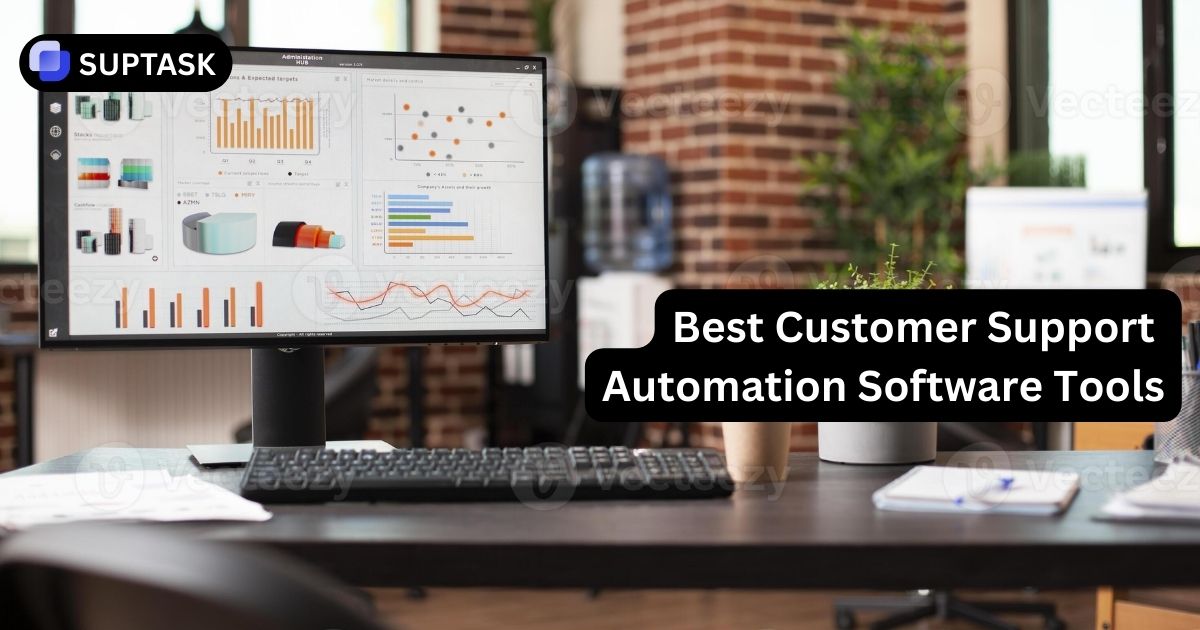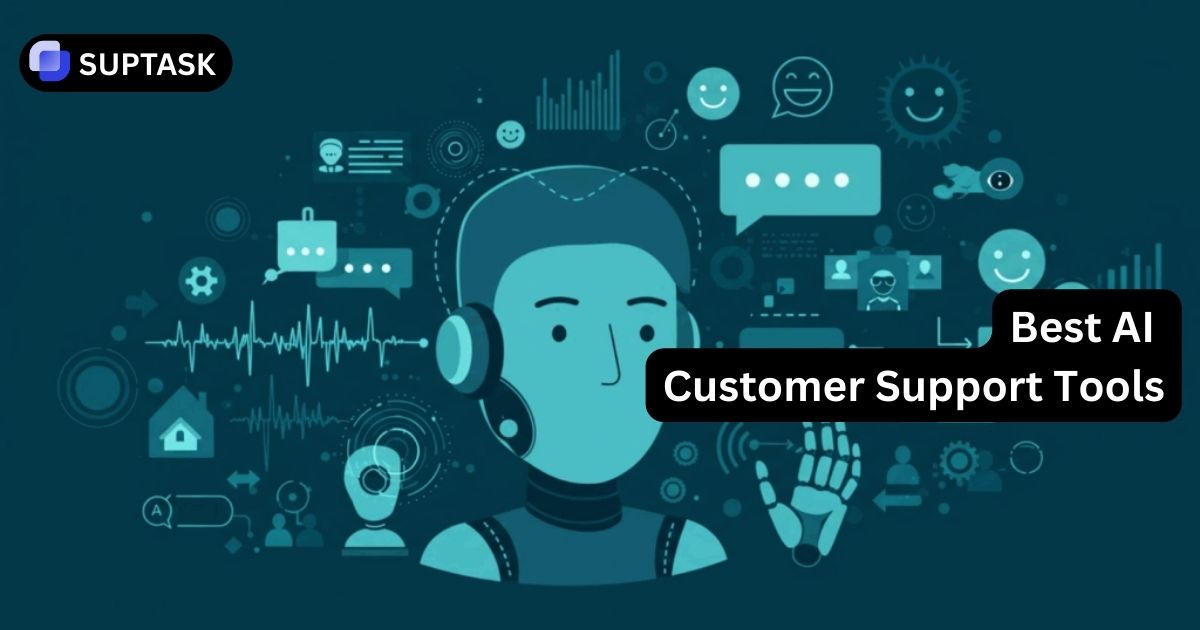Finding the right collaboration tool can transform your team from chaos to clockwork. We've tested 50+ platforms to bring you the 15 that actually deliver on their promises.
Quick Comparison: All 15 Tools at a Glance
Skip to what matters most for your team
| Tool | Best For | Starting Price | Key Strength |
|---|---|---|---|
|
Suptask
Top Pick
|
Ticketing within Slack | Free / $7/agent | Zero context switching |
|
Slack
Editor's Choice
|
Real-time team communication | Free / $7.25/user | Best chat experience |
Microsoft Teams |
Microsoft 365 users | Free / $4/user | Office integration |
Asana |
Project management | Free / $10.99/user | Visual workflows |
Trello |
Simple task tracking | Free / $5/user | Kanban simplicity |
Monday.com |
Customizable workflows | Free / $9/user | Flexibility |
Google Workspace |
Document collaboration | $6/user | Real-time editing |
Jira |
Software development | Free / $7.53/user | Agile workflows |
Zoom |
Video meetings | Free / $13.32/user | Meeting reliability |
Miro |
Visual brainstorming | Free / $8/user | Infinite canvas |
Smartsheet |
Enterprise workflows | $9/user | Spreadsheet power |
Wrike |
Complex projects | Free / $9.80/user | Resource management |
Notion |
All-in-one workspace | Free / $10/user | Ultimate flexibility |
Dropbox |
File collaboration | $9.99/user | Sync reliability |
Airtable |
Database workflows | Free / $20/user | No-code apps |
Find Tools by Your Team's Needs
Suptask
Turn Slack Into Your Support Command Center

Suptask transforms Slack into a powerful ticketing system without forcing your team to learn new software. Create tickets from any message, manage them through their lifecycle, and leverage AI to resolve issues faster. Perfect for teams that live in Slack but need proper internal ticketing system capabilities.
See How Easy It Is
React with 🎫 to create a ticket
Simple Per-Agent Pricing
| Feature | Without Suptask | With Suptask |
|---|---|---|
| Ticket Creation | Not available in Slack | Seamless in Slack |
| Task Assignment | Manual switching | Automated workflows |
| Communication | Scattered across tools | Unified in one place |
| Response Time | Hours to days | Minutes with AI |
| Context Preservation | Lost in tool switching | Maintained in threads |
✓ Strengths
- • Seamless Slack integration for ticket management
- • Customizable ticket forms and fields
- • AI-powered assistance for quick resolutions
- • Flexible pricing for all team sizes
- • Extensive integrations with 300+ tools
- • Advanced analytics and reporting
✗ Limitations
- • Dependent on Slack ecosystem
- • Advanced features in higher plans
- • Learning curve for new Slack users
- • Requires active Slack workspace
- • Customization needs time investment
Slack
The Digital HQ That Actually Works

Slack revolutionized team communication by organizing conversations into channels instead of endless email threads. Features like Huddles for quick audio chats and Slack screen sharing make remote collaboration feel natural. Plus, the ability to send GIFs in Slack keeps team morale high.
Transparent Pricing
✓ Strengths
- • Industry-leading user experience
- • Massive app ecosystem
- • Excellent search functionality
- • Strong security features
✗ Limitations
- • Can be overwhelming for new users
- • Expensive for large teams
- • Limited video capabilities
Microsoft Teams
Your Office 365 Collaboration Hub

Microsoft Teams brings together chat, meetings, files, and Office apps in one place. If your organization already uses Microsoft 365, Teams provides seamless integration with Word, Excel, PowerPoint, and more. Perfect for enterprises that need robust security and compliance features.
✓ Strengths
- • Deep Microsoft 365 integration
- • Excellent video conferencing
- • Enterprise-grade security
- • Teams Rooms for hybrid work
✗ Limitations
- • Can be resource-heavy
- • Complex interface
- • Limited without Office 365
Asana
Work Management That Scales With You

Asana turns chaos into clarity by organizing work into projects, tasks, and subtasks. Multiple views (List, Board, Timeline, Calendar) let teams work their way. The platform shines with its Goals feature that connects daily tasks to company objectives, ensuring everyone stays aligned.
Trello
Visual Simplicity at Its Best

Trello's card-based system makes project management visual and intuitive. Move cards across lists to track progress, add checklists for subtasks, and use Power-Ups to extend functionality. Perfect for teams that prefer simplicity over complexity.
Monday.com
The Work OS for Any Workflow

Monday.com lets you build custom workflows without code. Its colorful, intuitive interface makes project tracking enjoyable. With 200+ templates and powerful automation, teams can manage everything from marketing campaigns to product launches in one place.
Google Workspace
Real-Time Collaboration Redefined

Google Workspace brings the power of real-time collaboration to documents, spreadsheets, and presentations. Watch teammates' cursors move across the page as they edit. Combined with Gmail, Calendar, and Drive, it's a complete productivity suite that works anywhere.
Jira
Built for Agile Software Teams

Jira is the gold standard for software development teams. Built for Scrum and Kanban workflows, it tracks issues, manages sprints, and integrates with your entire development toolchain. If you're building software, Jira speaks your language.
Zoom
Video Meetings That Just Work

Zoom became synonymous with video meetings for a reason. Crystal-clear quality, reliable connections, and features like breakout rooms make it perfect for everything from team standups to company all-hands. The AI Companion helps with meeting summaries and action items.
Miro
The Infinite Canvas for Big Ideas

Miro transforms brainstorming with its infinite digital whiteboard. Perfect for remote workshops, design sprints, and strategic planning. With 2500+ templates and deep integrations with tools like Jira and Zoom, it's where ideas come to life visually.
Smartsheet
Enterprise Work Management at Scale

Smartsheet combines the familiarity of spreadsheets with powerful project management features. Perfect for teams that think in rows and columns but need Gantt charts, automation, and enterprise-grade security. Scales from small projects to entire portfolios.
Wrike
Versatile Project Management for Complex Work

Wrike adapts to how your team works with customizable workflows, powerful automation, and real-time collaboration. Built-in proofing and approval tools make it perfect for creative teams. Enterprise features include resource management and advanced analytics.
Notion
Your All-in-One Workspace

Notion breaks the mold by combining notes, docs, wikis, and databases in one flexible workspace. Build anything from a simple to-do list to a complex company wiki. With Notion AI built-in, you can summarize, translate, and generate content instantly.
Dropbox
More Than Storage - It's Content Collaboration

Dropbox evolved from simple file storage to a complete content collaboration platform. Share massive files up to 250GB, collect feedback on videos with Replay, sign documents electronically, and keep everything synced across all devices. Perfect for creative teams handling large assets.
Airtable
Spreadsheets Reimagined as Powerful Apps

Airtable combines the simplicity of spreadsheets with the power of databases. Build custom apps without code, automate workflows with AI, and connect data across your entire organization. Perfect for teams that need more than a spreadsheet but less than custom software.
Ready to Transform Your Team's Collaboration?
If you're already using Slack, why not supercharge it with proper ticketing and task management? Suptask brings structure to your conversations without forcing you to learn new tools.
Try Suptask Free →












